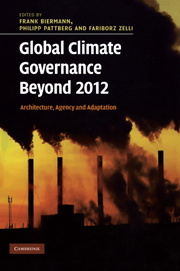Book contents
- Frontmatter
- Contents
- List of contributors
- Preface
- List of abbreviations
- 1 Global climate governance beyond 2012
- Part I Architecture
- 2 The architecture of global climate governance
- 3 The consequences of a fragmented climate governance architecture
- 4 Environmental effectiveness and economic consequences of fragmented versus universal regimes
- 5 Developing the international carbon market beyond 2012
- 6 The overlap between the UN climate regime and the World Trade Organization
- 7 An architecture for long-term climate change
- 8 Shaping the architecture of future climate governance
- Part II Agency
- Part III Adaptation
- Index
- References
8 - Shaping the architecture of future climate governance
perspectives from the South
Published online by Cambridge University Press: 05 July 2014
- Frontmatter
- Contents
- List of contributors
- Preface
- List of abbreviations
- 1 Global climate governance beyond 2012
- Part I Architecture
- 2 The architecture of global climate governance
- 3 The consequences of a fragmented climate governance architecture
- 4 Environmental effectiveness and economic consequences of fragmented versus universal regimes
- 5 Developing the international carbon market beyond 2012
- 6 The overlap between the UN climate regime and the World Trade Organization
- 7 An architecture for long-term climate change
- 8 Shaping the architecture of future climate governance
- Part II Agency
- Part III Adaptation
- Index
- References
Summary
Introduction
The urgent need for a globally concerted effort to address climate change has been acknowledged by all countries; yet the core challenge in designing a global climate governance architecture is to arrive at a universally acceptable multilateral agreement that will ensure that climate change is addressed in a coordinated and holistic manner (Lewis and Diringer 2007). Throughout the climate negotiations there have been disagreements among countries on specific provisions and principles (Kilaparti 1990; Redclift and Sage 1998; Rajamani 2003), resulting in ‘fragmented’ global climate governance architecture (Biermann et al., this volume, Chapter 2; Zelli et al., this volume, Chapter 3; Asselt et al. 2008). Such disagreements and the consequent fragmentation in global climate governance architecture, however, are not peculiar to climate negotiations. The literature on the evolution of institutions and international law, for instance, suggests that global governance architectures are in general determined and influenced by conflicting economic and political interests, differential technological and economic capabilities, jurisdictional constraints and at times cultural differences (North 1990; Cooter 1998; Boyle 1999). According to Boyle (1999), these unavoidable factors not only constrain the effectiveness of the involved institutions, but may also induce varying degrees of institutional fragmentation across the institutional architecture.
Biermann et al. (this volume, Chapter 2) and Zelli et al. (this volume, Chapter 3) discuss the fragmentation in climate governance architecture in detail and argue that even though a universal architecture is more effective than a fragmented one, the former is not a feasible option. Therefore, the best option for effective global climate governance is a low degree of synergistic fragmentation, that is, detailed general principles for regulating the policies in distinct yet substantially integrated institutional arrangements. This chapter looks at this proposition from the perspective of developing countries and identifies key principles for future global climate governance architecture that may encourage and enable developing countries to not only take up a greater responsibility in climate change mitigation – the core objective of any climate regime – but also achieve a sustainable development path.
- Type
- Chapter
- Information
- Global Climate Governance Beyond 2012Architecture, Agency and Adaptation, pp. 116 - 134Publisher: Cambridge University PressPrint publication year: 2010
References
- 1
- Cited by



